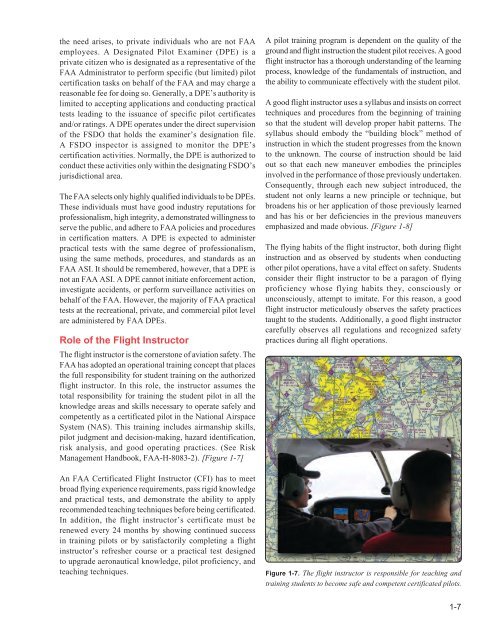You also want an ePaper? Increase the reach of your titles
YUMPU automatically turns print PDFs into web optimized ePapers that Google loves.
the need arises, to private individuals who are not FAA<br />
employees. A Designated Pilot Examiner (DPE) is a<br />
private citizen who is designated as a representative of the<br />
FAA Administrator to perform specific (but limited) pilot<br />
certification tasks on behalf of the FAA and may charge a<br />
reasonable fee for doing so. Generally, a DPE’s authority is<br />
limited to accepting applications and conducting practical<br />
tests leading to the issuance of specific pilot certificates<br />
and/or ratings. A DPE operates under the direct supervision<br />
of the FSDO that holds the examiner’s designation file.<br />
A FSDO inspector is assigned to monitor the DPE’s<br />
certification activities. Normally, the DPE is authorized to<br />
conduct these activities only within the designating FSDO’s<br />
jurisdictional area.<br />
The FAA selects only highly qualified individuals to be DPEs.<br />
These individuals must have good industry reputations for<br />
professionalism, high integrity, a demonstrated willingness to<br />
serve the public, and adhere to FAA policies and procedures<br />
in certification matters. A DPE is expected to administer<br />
practical tests with the same degree of professionalism,<br />
using the same methods, procedures, and standards as an<br />
FAA ASI. It should be remembered, however, that a DPE is<br />
not an FAA ASI. A DPE cannot initiate enforcement action,<br />
investigate accidents, or perform surveillance activities on<br />
behalf of the FAA. However, the majority of FAA practical<br />
tests at the recreational, private, and commercial pilot level<br />
are administered by FAA DPEs.<br />
Role of the Flight Instructor<br />
The flight instructor is the cornerstone of aviation safety. The<br />
FAA has adopted an operational training concept that places<br />
the full responsibility for student training on the authorized<br />
flight instructor. In this role, the instructor assumes the<br />
total responsibility for training the student pilot in all the<br />
knowledge areas and skills necessary to operate safely and<br />
competently as a certificated pilot in the National Airspace<br />
System (NAS). This training includes airmanship skills,<br />
pilot judgment and decision-making, hazard identification,<br />
risk analysis, and good operating practices. (See Risk<br />
Management <strong>Handbook</strong>, FAA-H-8083-2). [Figure 1-7]<br />
An FAA Certificated Flight Instructor (CFI) has to meet<br />
broad flying experience requirements, pass rigid knowledge<br />
and practical tests, and demonstrate the ability to apply<br />
recommended teaching techniques before being certificated.<br />
In addition, the flight instructor’s certificate must be<br />
renewed every 24 months by showing continued success<br />
in training pilots or by satisfactorily completing a flight<br />
instructor’s refresher course or a practical test designed<br />
to upgrade aeronautical knowledge, pilot proficiency, and<br />
teaching techniques.<br />
A pilot training program is dependent on the quality of the<br />
ground and flight instruction the student pilot receives. A good<br />
flight instructor has a thorough understanding of the learning<br />
process, knowledge of the fundamentals of instruction, and<br />
the ability to communicate effectively with the student pilot.<br />
A good flight instructor uses a syllabus and insists on correct<br />
techniques and procedures from the beginning of training<br />
so that the student will develop proper habit patterns. The<br />
syllabus should embody the “building block” method of<br />
instruction in which the student progresses from the known<br />
to the unknown. The course of instruction should be laid<br />
out so that each new maneuver embodies the principles<br />
involved in the performance of those previously undertaken.<br />
Consequently, through each new subject introduced, the<br />
student not only learns a new principle or technique, but<br />
broadens his or her application of those previously learned<br />
and has his or her deficiencies in the previous maneuvers<br />
emphasized and made obvious. [Figure 1-8]<br />
The flying habits of the flight instructor, both during flight<br />
instruction and as observed by students when conducting<br />
other pilot operations, have a vital effect on safety. Students<br />
consider their flight instructor to be a paragon of flying<br />
proficiency whose flying habits they, consciously or<br />
unconsciously, attempt to imitate. For this reason, a good<br />
flight instructor meticulously observes the safety practices<br />
taught to the students. Additionally, a good flight instructor<br />
carefully observes all regulations and recognized safety<br />
practices during all flight operations.<br />
Figure 1-7. The flight instructor is responsible for teaching and<br />
training students to become safe and competent certificated pilots.<br />
1-7


